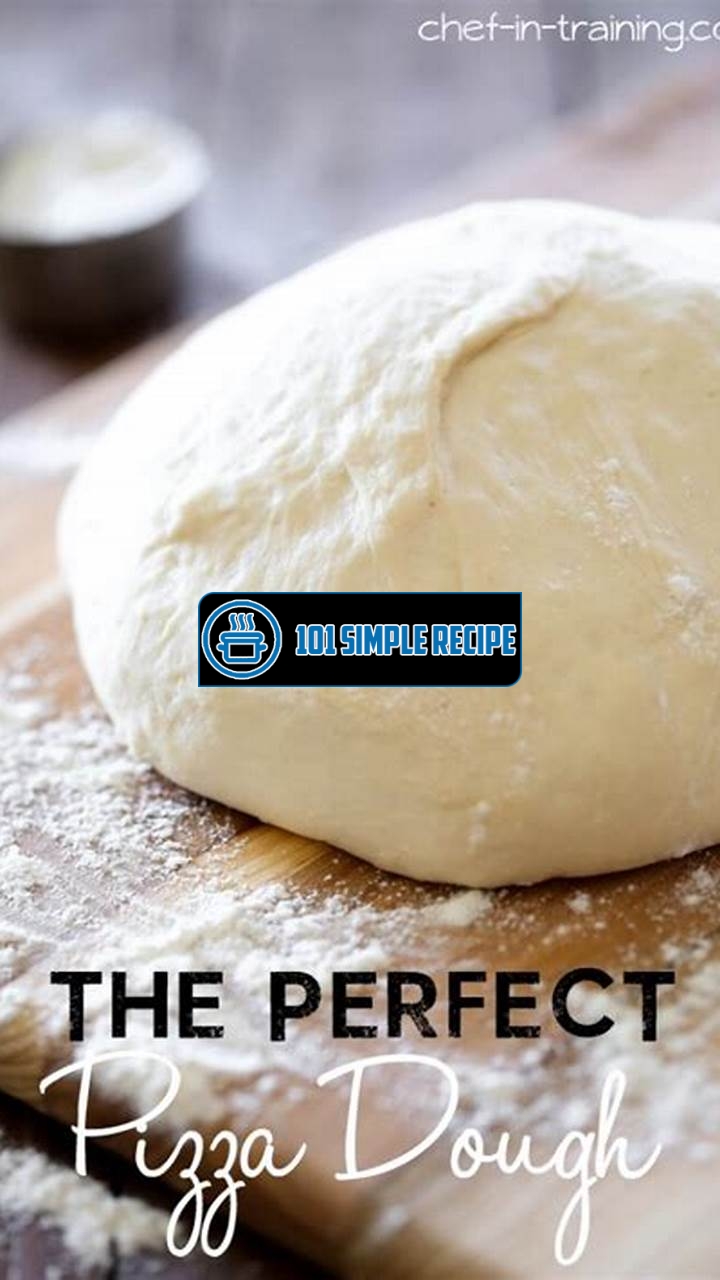If you’ve ever dreamed of creating the perfect pizza from scratch, then you’re in for a treat. In this article, we will explore the art of making pizza dough as a profession, allowing you to master the craft and create delectable pizzas time and time again. Whether you’re a seasoned professional looking to elevate your skills or a passionate home cook ready to take your pizza game to the next level, we’ve got you covered. From finding the right ingredients to perfecting the kneading technique, we’ll guide you through every step of the process, ensuring that your pizzas are nothing short of perfection. So grab your rolling pin, put on your apron, and let’s dive into the world of pizza-making mastery.

The Basics of Pizza Dough
Pizza dough is the foundation of a perfect pizza. It is the canvas on which all the toppings and flavors are built. To master the art of making pizza as a profession, it is essential to understand the basics of pizza dough and the role of its key elements – flour, yeast, and water.
The Role of Flour in Pizza Dough
Flour is a fundamental ingredient in pizza dough, providing structure, texture, and flavor to the final product. When it comes to choosing the right flour for pizza dough, it is crucial to opt for high-protein varieties. High-protein flours, such as bread flour or Tipo 00 flour, contain more gluten, which gives elasticity and chewiness to the dough. This elasticity is essential as it allows the dough to rise and hold its shape when baking.
Tip: Choose high-protein flour like bread flour or Tipo 00 flour for a dough with excellent elasticity and chewiness.
Another consideration when selecting flour for pizza dough is the grind. Fine-grind flours, like Tipo 00, result in a smoother texture, while coarser whole-wheat flours can add nuttiness and a heartier flavor. Experimenting with different flours can help you achieve the desired taste and texture for your pizza dough.
Tip: Try using different types of flour to add unique flavors and textures to your pizza dough.
The Importance of Yeast in Pizza Dough
Yeast is a crucial ingredient in pizza dough as it helps the dough rise and develop a light and airy texture. There are two main types of yeast used in pizza dough: active dry yeast and instant yeast. Both types need to be activated by warm water before adding them to the dough.
Active dry yeast requires proofing, which involves dissolving it in warm water with a small amount of sugar. This step allows the yeast to activate and start fermenting, resulting in carbon dioxide production and dough expansion. On the other hand, instant yeast can be added directly to the dry ingredients without proofing, saving time and simplifying the process.
Tip: Activate active dry yeast in warm water with a pinch of sugar to ensure optimal fermentation and rise.
Yeast also plays a significant role in flavor development. Longer fermentation times allow the yeast to produce more complex flavors, resulting in a tastier pizza crust. By using cold fermentation techniques or incorporating a sourdough starter, you can enhance the flavor complexity of your dough.
Tip: Experiment with longer fermentation times or sourdough starters to add more depth and complexity to your pizza dough.
The Influence of Water in Pizza Dough
Water is a vital element in pizza dough, affecting its texture, temperature, and overall hydration. The amount of water used in the dough can significantly impact the final outcome of your pizza crust. Getting the right hydration level is crucial to achieving the desired texture and crispness.
Tip: Adjust the amount of water to achieve the desired texture and crispness in your pizza crust.
Furthermore, the temperature of the water used in the dough can affect the fermentation process. Warmer water can activate the yeast faster, resulting in quicker rising times. On the other hand, colder water slows down the yeast’s activity, allowing for a more extended fermentation period and enhanced flavor development.
Tip: Control the water temperature to control the fermentation process and achieve optimal flavor development. ❄️
Moreover, different types of water, such as tap water or spring water, may contain varying mineral compositions. These minerals can impact the dough’s characteristics, including its texture, flavor, and even color. Experimenting with different types of water can help you discover the ideal combination for your signature pizza dough.
Tip: Try using different types of water to explore the impact of mineral compositions on your pizza dough.
In conclusion, mastering the art of making pizza as a profession requires a deep understanding of the basics of pizza dough. The role of flour, yeast, and water in creating the perfect pizza crust cannot be underestimated. By experimenting with different ingredients, techniques, and temperatures, you can unlock the secrets to crafting exceptional pizza dough that forms the foundation of unforgettable pizzas.
For a sweet treat, try our cookie in a mug recipe. It’s a quick and easy dessert that you can enjoy anytime.
The Art of Kneading and Fermentation
Discover the techniques of kneading and fermentation that contribute to the texture and flavor of pizza dough.
Kneading: The Key to Developing Gluten
When it comes to creating the perfect pizza dough, kneading is a crucial step. Kneading dough helps develop the gluten, which gives the dough its elastic and stretchy texture. Gluten is a group of proteins found in wheat flour that, when mixed with water and kneaded, form a network of strands. This network is responsible for trapping air bubbles during the fermentation process, resulting in a light and airy crust.
To knead the dough effectively, start by combining your ingredients in a mixing bowl. Gradually add water and mix until the dough comes together. Once the dough is formed, transfer it to a clean, floured surface. Use the heel of your hand to push the dough away from you, then fold it back over itself. Repeat this motion, applying pressure with the heel of your hand, for about 10-15 minutes. The dough should become smooth and elastic.
Important Point: Properly kneading the dough is essential for developing gluten, which contributes to a light and airy crust.
The Science Behind Fermentation
Fermentation is a process that occurs when yeast consumes sugars in the dough and produces carbon dioxide gas. This gas creates air pockets within the dough, allowing it to rise and develop a light and airy texture. Understanding the science behind fermentation can help you master the art of making pizza dough.
The main component of fermentation is yeast, a microorganism that feeds on sugar and produces carbon dioxide as a byproduct. Yeast is activated in the presence of warm water, which provides the ideal environment for growth. As the yeast consumes the sugars in the dough, it releases carbon dioxide, causing the dough to rise.
Temperature and time play crucial roles in the fermentation process. Typically, dough is left to ferment at room temperature for several hours. This allows the yeast to multiply and produce enough carbon dioxide to leaven the dough. However, the exact time required for fermentation can vary depending on factors such as the type of yeast used and the temperature of the room.
Important Point: Understanding the fermentation process is key to achieving a well-risen and flavorful pizza dough.
The Significance of Proofing Dough
Proofing dough is the final step in the fermentation process before shaping and baking it into a delicious pizza. It allows the dough to relax and develop additional flavor.
Proofing involves allowing the dough to rest and rise one final time before baking. This process can be done by placing the dough in a covered bowl and letting it sit in a warm environment for a specified period. This rest period allows the yeast to continue producing carbon dioxide and flavors to develop further.
During proofing, the dough also undergoes a slight fermentation, which helps enhance its flavor. The longer you proof your dough, the more complex and developed the flavors will be.
Important Point: Properly proofing your dough is vital for achieving an enhanced flavor and texture in the final pizza crust.
In conclusion, mastering the art of making pizza dough as a profession requires a deep understanding of kneading and fermentation techniques. By kneading the dough properly, you can develop gluten and create a light and airy crust. Understanding the science behind fermentation enables you to harness the power of yeast and achieve a flavorful and well-risen dough. Lastly, giving the dough sufficient time to proof allows for additional flavor development and enhances the overall quality of the final pizza crust. With practice and attention to these techniques, you can create the perfect pizza dough every time.
If you’re looking for other delicious recipes, you should check out our garlic bread stick recipe. It’s a perfect accompaniment to your homemade pizza dough!
Secrets to Making the Perfect Dough Ball
Uncover the secrets to forming the ideal dough ball for professional pizza making.
Choosing the Right Size and Weight
When it comes to making the perfect pizza dough, one of the first things you need to consider is the size and weight of the dough ball. The size and weight of the dough ball will ultimately determine the size of the pizza crust you end up with. Depending on your preference and the style of pizza you are making, you’ll need to choose the appropriate size and weight for the dough ball.
For thin crust pizzas, you’ll want to opt for a smaller and lighter dough ball. This will result in a thinner and crispier crust, which is ideal for those who enjoy a crunchy texture. On the other hand, if you prefer a thicker and chewier crust, go for a larger and heavier dough ball. This will give you that perfect combination of crispy on the outside and soft on the inside.
It’s important to note that the size and weight of the dough ball will also depend on the size of your pizza oven and the type of pizza you are making. For wood-fired pizzas, smaller and lighter dough balls are often used as they cook quickly in the high heat of the oven. However, for deep-dish or pan pizzas, larger and heavier dough balls are necessary to create that thick and fluffy crust.
The Proper Technique for Shaping the Dough
Once you have chosen the right size and weight for your dough ball, the next step is to shape it properly. Shaping the dough ball correctly can make all the difference in the final outcome of your pizza crust. The key is to handle the dough gently and not overwork it.
Start by lightly flouring your work surface to prevent the dough from sticking. Place the dough on the floured surface and gently press it down with your fingertips to flatten it slightly. Then, working from the center outwards, use your fingertips to push the dough away from you and then fold it back towards you. Repeat this motion several times until the dough ball becomes smooth and elastic.
Remember, it’s important not to apply too much pressure or stretch the dough too thin during this process. Doing so can cause the dough to tear or become uneven, resulting in an undesirable pizza crust. Take your time and be patient as you shape the dough ball, and you’ll be rewarded with a beautifully formed crust.
The Importance of Resting the Dough Ball
Resting the dough ball is a crucial step in the pizza-making process. It allows the gluten in the dough to relax and the flavors to develop, resulting in a more flavorful and tender crust. The length of time you should let the dough ball rest will depend on the recipe you are using, but it is generally recommended to rest the dough for at least 24 hours.
During the resting period, cover the dough ball with a clean towel or plastic wrap to prevent it from drying out. This will also help to keep the dough from forming a crust on the surface. Place the dough ball in a cool, dark place, such as the refrigerator, to allow it to ferment slowly.
After the resting period, you’ll notice that the dough ball has increased in size and has a bubbly texture. This is a sign that the yeast in the dough has been activated and has started to produce carbon dioxide, causing the dough to rise. The rested dough ball is now ready to be used to create your perfect pizza crust.
In conclusion, mastering the art of making the perfect pizza dough as a profession requires understanding the secrets to forming the ideal dough ball. By choosing the right size and weight, shaping the dough properly, and allowing it to rest, you can achieve a delicious and professional-quality pizza crust every time.
Baking Pizza to Perfection
When it comes to creating the perfect pizza, achieving the ideal crust is the key. The crust is what holds the entire pizza together and provides that satisfying crunch with every bite. To bake a pizza with impeccable crust, there are several crucial factors that you need to consider. Let’s delve into these factors and master the art of making the perfect pizza dough as a profession.
The Role of Oven Temperature
The oven temperature plays a vital role in achieving the perfect crust. You need to preheat your oven to a high temperature, typically around 500°F (260°C), to ensure that the dough cooks evenly and quickly. The high heat creates a crisp exterior while keeping the interior soft and fluffy. It is essential to invest in a good oven thermometer to accurately monitor the temperature and make necessary adjustments.
Important Point: Remember, the right temperature is crucial for achieving the perfect pizza crust.
Understanding Different Baking Surfaces
The baking surface you choose also affects the outcome of your pizza crust. There are various options to consider, each with its distinct characteristics. A pizza stone is a popular choice as it absorbs moisture, resulting in a crispier crust. Another option is using a baking steel, which conducts heat more efficiently, allowing for a quicker bake and a slightly different texture. If you don’t have access to these specialized tools, a baking sheet or even a cast-iron skillet can work well too.
⚖️ Note: Experiment with different baking surfaces to find the one that suits your taste preferences and the type of crust you desire.
Tips for Achieving the Ideal Crust Texture
Achieving the ideal crust texture requires attention to detail and some tried-and-true techniques. Here are a few tips to help you master the art of creating the perfect pizza crust:
- Knead the dough thoroughly: Properly kneading the dough helps develop gluten, resulting in a more elastic and airy crust. Aim for a smooth and slightly tacky texture.
- Allow the dough to rise: Allowing the dough to rise for an adequate amount of time is crucial. It gives the yeast a chance to ferment the sugars, creating air pockets that give the crust its light and fluffy texture. Depending on the recipe, this can take anywhere from a few hours to overnight in the refrigerator.
- Use quality ingredients: The ingredients you use can make a significant difference in the final outcome. Opt for high-quality flour, fresh yeast, and extra-virgin olive oil to enhance the flavor and texture of the crust.
- Practice stretching the dough: Stretching the dough properly helps create that desirable thin and crispy crust. Start by gently pressing and stretching the dough from the center outward, being careful not to tear it. Rotate the dough as you go to achieve an even thickness.
- Consider par-baking the crust: Par-baking the crust for a few minutes before adding the toppings can help prevent a soggy bottom. This technique is especially beneficial when using wet or heavy ingredients.
Pro Tip: Experiment with different techniques to find the perfect combination that works for you and your desired crust texture.
By paying attention to the oven temperature, selecting the right baking surface, and implementing these tips, you can master the art of making the perfect pizza dough as a profession. Remember, practice makes perfect, so don’t be afraid to experiment and fine-tune your techniques. Soon, you’ll be known for creating pizzas with impeccable crust that will delight any pizza lover.
Looking for a different type of bread? Try our kaiser roll recipe. It’s great for sandwiches or burgers!
Mastering the Toppings and Flavor Combinations
When it comes to making the perfect pizza, mastering the toppings and flavor combinations is a crucial skill to have as a professional. With the right toppings and flavor combinations, you can elevate your pizza experience and create delicious masterpieces that will keep your customers coming back for more.
Choosing the Freshest and Highest-Quality Ingredients
The first step in mastering the toppings and flavor combinations is choosing the freshest and highest-quality ingredients. Using fresh and high-quality ingredients will not only enhance the taste of your pizza but also ensure its nutritional value.
Start by selecting the best quality dough. A good dough is the foundation of a great pizza. It should be soft, chewy, and have a slight tangy flavor. Freshly grated cheese adds a rich and creamy texture to your pizza. Opt for high-quality mozzarella cheese for that perfect melt-in-your-mouth experience.
Next, focus on the sauce. A flavorful sauce is essential for every pizza. Use ripe and juicy tomatoes to make a homemade sauce and add your favorite herbs and spices to enhance the taste. Don’t forget to add a pinch of salt and a dash of sugar to balance the flavors.
Now it’s time to choose your toppings. The key here is to think outside the box and explore unique combinations. Opt for fresh vegetables like bell peppers, mushrooms, and onions. Add some protein with cooked chicken, Italian sausage, or pepperoni. Don’t be afraid to experiment with different flavors and textures.
Lastly, don’t underestimate the power of fresh herbs. Basil, oregano, and rosemary can add a refreshing aroma and depth of flavor to your pizza. Sprinkle them on top just before serving to enhance the overall taste.
Understanding Flavor Balancing
Another important aspect of mastering toppings and flavor combinations is understanding flavor balancing. It’s all about finding the perfect harmony between sweet, salty, sour, and bitter flavors.
Start by understanding flavor profiles. Sweet flavors can come from ingredients like caramelized onions or sweet peppers. Salty flavors can be achieved with ingredients like olives or anchovies. Sour flavors can be added with a squeeze of lemon or a drizzle of balsamic vinegar. Bitter flavors can come from ingredients like arugula or radicchio.
Experiment with different combinations and proportions to create balance. For example, if you have a sweet ingredient, pair it with something salty or sour to cut through the sweetness. If you have a bitter ingredient, balance it with something sweet or salty.
Exploring Unique Topping Combinations
Finally, when it comes to mastering toppings and flavor combinations, don’t be afraid to explore unique combinations. Try something unexpected and let your creativity run wild.
Consider adding fruits like pineapple or figs to create a sweet and savory flavor profile. Combine different types of cheese for a complex and rich taste. Experiment with spices like chili flakes, smoked paprika, or truffle oil to add a kick of flavor. The possibilities are endless.
Remember to always taste as you go and adjust the flavors accordingly. Trust your instincts and let your taste buds guide you. With practice and a creative mindset, you’ll soon become a master at creating the perfect pizza dough with tantalizing toppings and flavor combinations.
Thank you for taking the time to read about the perfect pizza dough pizza as a profession. We hope you found this article informative and inspiring. Whether you are a professional chef or a passionate home cook, mastering the art of pizza dough is a skill that can elevate your culinary creations to new heights. Remember to practice, experiment, and have fun in the process as you embark on your pizza-making journey. We encourage you to visit our website again for more delicious recipes, tips, and tricks to enhance your culinary adventures. Stay tuned for more exciting content coming soon!
Frequently Asked Questions
Here are some frequently asked questions about the perfect pizza dough pizza as a profession:
| No. | Questions | Answers |
|---|---|---|
| 1. | How long does it take to make the perfect pizza dough? | The time required to make the perfect pizza dough varies depending on the recipe and the method used. However, on average, it takes approximately 1 to 2 hours from start to finish, including resting and rising time. |
| 2. | What type of flour should I use for pizza dough? | The best flour for pizza dough is high-protein flour, such as bread flour or Tipo 00 flour. These flours have a higher gluten content, which results in a chewier and more elastic dough. |
| 3. | Can I make pizza dough in advance? | Yes, you can make pizza dough in advance. After kneading and shaping the dough, you can refrigerate it for up to 72 hours. This slow fermentation process enhances the flavor and texture of the dough. |
| 4. | What is the best way to shape pizza dough? | There are various methods to shape pizza dough, including stretching it by hand, using a rolling pin, or tossing it in the air. The key is to be gentle and avoid overworking the dough, as this can result in a tough crust. |
| 5. | Do I need a pizza stone to bake pizza? | While a pizza stone can help achieve a crispier crust, it is not necessary. You can also use a baking sheet or a cast iron skillet to bake your pizza. |
| 6. | Can I freeze pizza dough? | Absolutely! Freezing pizza dough is a convenient way to have homemade dough on hand whenever you crave pizza. After shaping the dough, you can wrap it tightly in plastic wrap and freeze it for up to 3 months. |
The Perfect Pizza Dough Pizza as a Profession
Thank you once again for joining us on this culinary journey exploring the art of making the perfect pizza dough as a profession. With the knowledge and techniques shared in this article, you are now equipped to create delicious and professional-quality pizzas in your own kitchen. Remember to select the finest ingredients, pay attention to every detail, and let your passion for pizza shine through. Whether you’re serving your creations to friends and family or considering a career in the culinary world, we wish you success and endless enjoyment in your pizza-making endeavors. Keep experimenting, honing your skills, and making dough like a pro. Until next time, happy pizza making!
Jump to Recipe
The Perfect Pizza Dough Pizza as a Profession

Learn how to make the perfect pizza dough and turn your passion for pizza into a profession. This article provides expert tips, techniques, and recipes to help you create professional-quality pizzas in your own kitchen.
- 3 cups bread flour
- 2 teaspoons active dry yeast
- 2 teaspoons sugar
- 2 teaspoons salt
- 1 1/4 cups warm water
- 2 tablespoons olive oil
- In a small bowl, combine the warm water, yeast, and sugar. Let it sit for 5 minutes until it becomes foamy.
- In a large bowl, combine the bread flour and salt. Make a well in the center and pour in the yeast mixture and olive oil. Stir until a shaggy dough forms.
- Transfer the dough onto a lightly floured surface. Knead for about 10 minutes until it becomes smooth and elastic.
- Place the dough in a greased bowl and cover it with a clean kitchen towel. Let it rise in a warm place for about 1 hour or until it doubles in size.
- Gently deflate the dough by pressing your fist into the center. Remove it from the bowl and divide it into 4 equal portions.
- Working with one portion at a time, shape the dough into a round ball. Use your fingertips to press and stretch the dough into a 10-inch circle.
- Preheat your oven to the highest temperature. Place the shaped dough onto a pizza peel or baking sheet. Add your desired toppings and bake for about 12-15 minutes or until the crust is golden brown and crispy.






